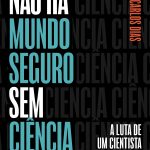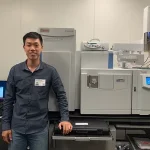Using (nano-) synchrotron radiation to unveil nanomaterials speciation changes in environmental solutions, and how co-existing microplastics can act as transportation vectors of the transformed species
Palestrante: Prof. Dr. Miguel A. Gomez-Gonzalez (Diamond Light Source, UK)
Abstract: Zinc oxide (ZnO) engineered nanomaterials (ENMs) are at the forefront of application-driven nanotechnology because of their advantageous properties, raising concerns about their potential impact as pollutants following their inevitable release into the environment (i.e., ZnO-based sunscreens to avoid direct sun radiation).
Likewise, plastic pollution has become a pressing environmental issue because the rate of disposable plastic manufacture has overcome our ability to process and recycle it efficiently. Once released to freshwater and seawater, ultraviolet (UV) exposure and mechanical abrasion can delaminate and degrade specific plastics, triggering their fragmentation into small plastic-debris and microplastics (MPs).
The ENMs can experience both spatial (i.e., aggregation, adsorption) and spectral (i.e., chemical speciation) modifications that can lead to different effects, ultimately affecting their eco-toxicity and hazardousness. Applying a cutting-edge methodology,1 based on in situ nanoscale X-ray fluorescence (nano-XRF) microscopy and X-ray absorption near edge structure (nano-XANES) spectroscopy mapping, we unveiled spatially resolved dissolution in real-time, as well as chemical evolution of ZnO nanorods within short incubation times (1-3 hours) in influent water and primary sludge collected from urban waste water environments. 2 The second aim of this research was to understand the influence of MPs as vectors for binding transformed ZnO, due to their increasing presence in relevant environmental scenarios. A combination of i) scanning electron microscopy (SEM), ii) nano-XRF and iii) nano-XANES was proposed to study how these ENMs adsorb to MPs at the nanoscale. Mixtures of incipient Zn-sulfide (kinetically favoured) and Zn-phosphate in the more accessible sites (thermodynamically preferred) were observed by XANES.3 Furthermore, “real life” matrices such as commercial sunscreens and cleanser exfoliating products, were used to evaluate the natural leaching of ZnO and microplastics subproducts, identifying the dynamics of MPs/ENMs interactions within simple aging and incubation protocols. It is precisely the complexity of studying MPs interaction with co-contaminants at the point of exposure, which makes difficult to extrapolate conclusions widely applicable. We propose to shed some light into this topic, by studying the polystyrene microplastic ability to sorb aged ZnO nanomaterials at the point of exposure, in relevant freshwater and seawater scenarios.
References: (1) Gomez-Gonzalez, M. A.; et al. ACS Nano 2019, 13 (10), 11049–11061. https://doi.org/10.1021/acsnano.9b02866.; (2) Gomez‐Gonzalez, M. A.; et al. Adv. Sustain. Syst. 2021, 2100023. https://doi.org/10.1002/adsu.202100023.; (3) Gomez-Gonzalez, M. A.; et al. Glob. Challenges 2023, 2300036. https://doi.org/10.1002/GCH2.202300036.
Short Bio: Miguel Gomez-Gonzalez is a Beamline Scientist working on beamline I14 – hard X-ray nanoprobe – at Diamond Light Source synchrotron (UK). Miguel joined Diamond in 2019, after 3 years of postdoctoral research at the Materials Department from Imperial College London (UK). Dr. Gomez-Gonzalez obtained a BS and MSc in Chemistry from the University of Zaragoza (Spain), and a PhD degree in Geochemistry/Analytical Chemistry at the National Museum of Natural Sciences (Spanish Council for Scientific Research, Madrid, Spain) in 2016.
During his PhD entitled “Combined application of spectroscopic and separation techniques for characterisation and speciation of toxic elements associated to colloidal vectors of geochemical interest”, Miguel tried to bridge the difficult gap between soil contamination and its mobilization through water resources as colloidal micro- and nanoparticles. There, he gained experience in laboratory experimental design and sample characterisation, by using a broad range of advanced analytical techniques such as Environmental Scanning and Transmission Electron Microscopy (ESEM/TEM), X-ray absorption spectroscopy (XAS, measured at international synchrotron facilities) and asymmetric flow field-flow fractionation (AF4) coupled to an inductively coupled plasma mass spectrometry (ICP-MS). More recently, Miguel focused his research on: i) investigating the fate, behaviour, and dissolution kinetics of engineered nanomaterials in freshwater solutions, ii) studying how the microplastics can act as transportation vectors of co-existing nano pollutants, with an interest on their subsequent incorporation to microorganisms and biota, and iii) synthesising isotopically labelled ZnO nanomaterials, among others. Miguel has extensive experience in the development of X-ray fluorescence (XRF) and phase-contrast imaging techniques, as well as X-ray adsorption spectroscopy near edge structure (XANES) for molecular-level speciation of elements, including the spatially resolved (in situ) transformation of nanomaterials.
For more information about the author, please visit the website: https://www.diamond.ac.uk/Instruments/Imaging-and-Microscopy/I14/Staff/Gomez-Gonzalez.html





